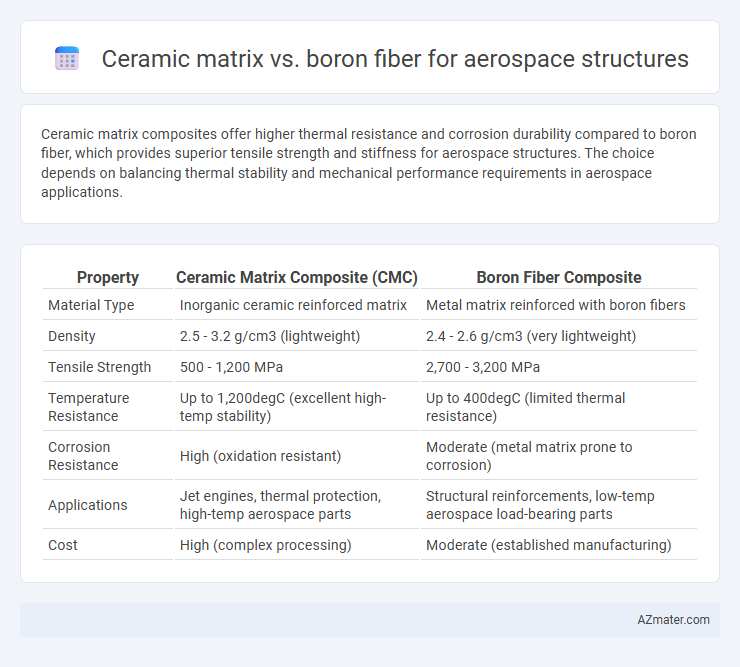Ceramic matrix composites offer higher thermal resistance and corrosion durability compared to boron fiber, which provides superior tensile strength and stiffness for aerospace structures. The choice depends on balancing thermal stability and mechanical performance requirements in aerospace applications.
Table of Comparison
| Property | Ceramic Matrix Composite (CMC) | Boron Fiber Composite |
|---|---|---|
| Material Type | Inorganic ceramic reinforced matrix | Metal matrix reinforced with boron fibers |
| Density | 2.5 - 3.2 g/cm3 (lightweight) | 2.4 - 2.6 g/cm3 (very lightweight) |
| Tensile Strength | 500 - 1,200 MPa | 2,700 - 3,200 MPa |
| Temperature Resistance | Up to 1,200degC (excellent high-temp stability) | Up to 400degC (limited thermal resistance) |
| Corrosion Resistance | High (oxidation resistant) | Moderate (metal matrix prone to corrosion) |
| Applications | Jet engines, thermal protection, high-temp aerospace parts | Structural reinforcements, low-temp aerospace load-bearing parts |
| Cost | High (complex processing) | Moderate (established manufacturing) |
Introduction to Aerospace Structural Materials
Ceramic matrix composites (CMCs) offer high-temperature resistance and excellent stiffness, making them ideal for aerospace structures subjected to extreme thermal environments. Boron fiber provides exceptional tensile strength and excellent fatigue resistance, commonly used in primary airframe components requiring superior load-bearing capacity. Both materials enhance aircraft performance by optimizing strength-to-weight ratios and durability in aerospace structural applications.
Overview of Ceramic Matrix Composites
Ceramic Matrix Composites (CMCs) consist of ceramic fibers embedded in a ceramic matrix, offering exceptional thermal stability and resistance to oxidation, making them ideal for high-temperature aerospace applications such as turbine engines and hypersonic vehicles. Compared to boron fibers, CMCs provide superior fracture toughness and reduced density, enabling lightweight structures without sacrificing structural integrity under extreme conditions. The material's capability to maintain strength at temperatures exceeding 1,200degC highlights its advantage over boron fiber composites, which typically have lower thermal limits and oxidation resistance.
Understanding Boron Fiber Composites
Boron fiber composites are renowned for their exceptional tensile strength, stiffness, and lightweight properties, making them ideal for aerospace structural applications where high performance and durability are critical. Compared to ceramic matrix composites, boron fiber composites offer superior fracture toughness and fatigue resistance, enhancing the structural integrity of aircraft components under dynamic loading conditions. Their unique ability to maintain mechanical properties at elevated temperatures further supports their widespread use in aerospace designs requiring reliable thermal stability and enhanced load-bearing capacity.
Mechanical Properties Comparison
Ceramic matrix composites exhibit excellent high-temperature strength and oxidation resistance, making them ideal for aerospace applications requiring thermal stability and durability. Boron fiber composites provide superior tensile strength and stiffness with lower density, leading to enhanced load-bearing capacity and weight reduction in aircraft structures. Mechanical properties such as fracture toughness and fatigue resistance tend to favor ceramic matrix composites for extreme environments, while boron fiber composites excel in impact resistance and elastic modulus for structural components.
Thermal Performance in Aerospace Environments
Ceramic matrix composites (CMCs) exhibit superior thermal stability and oxidation resistance at temperatures exceeding 1200degC, making them ideal for aerospace structures exposed to extreme thermal environments such as turbine engines and hypersonic vehicles. Boron fiber-reinforced composites offer high stiffness-to-weight ratios but have limited thermal performance, typically degrading above 700degC due to oxidation and loss of mechanical properties. The enhanced thermal conductivity and resistance to thermal shock in ceramic matrix materials provide more reliable structural integrity and longevity under fluctuating aerospace thermal conditions.
Weight and Density Analysis
Ceramic matrix composites (CMCs) exhibit higher density, typically around 3.0-3.2 g/cm3, compared to boron fibers, which have a lower density of approximately 2.6 g/cm3, making boron fibers more advantageous for weight-sensitive aerospace structures. The superior stiffness-to-weight ratio of boron fibers enhances structural efficiency by reducing overall component mass while maintaining high tensile strength. Density and weight analysis underline the preference for boron fibers in aerospace applications requiring minimum weight without compromising mechanical performance.
Durability and Resistance to Fatigue
Ceramic matrix composites exhibit superior high-temperature durability and resistance to oxidation, making them ideal for aerospace structures exposed to extreme thermal environments. Boron fiber composites provide excellent fatigue resistance due to their high tensile strength and stiffness but are more susceptible to environmental degradation over time. The choice between ceramic matrix and boron fiber materials hinges on balancing thermal stability with mechanical fatigue performance in aerospace applications.
Manufacturing Processes and Scalability
Ceramic matrix composites (CMCs) typically involve complex manufacturing processes such as chemical vapor infiltration (CVI) and slurry infiltration, which require high temperatures and precise control, leading to scalability challenges in aerospace production. Boron fiber composites are produced through more established techniques like filament winding and prepreg layup, offering better scalability and cost-efficiency for large-scale aerospace structural components. The thermal stability and damage tolerance of CMCs make them suitable for high-performance aerospace applications but require more advanced manufacturing infrastructure compared to the relatively mature and scalable boron fiber processes.
Cost Efficiency and Material Availability
Ceramic matrix composites (CMCs) offer high-temperature resistance and corrosion durability but often come with higher production costs and limited large-scale availability compared to boron fiber, which benefits from established manufacturing processes and moderate pricing. Boron fiber provides favorable strength-to-weight ratios and widespread accessibility, making it cost-efficient for aerospace structures requiring stiffness and toughness at lower temperatures. Material selection in aerospace applications hinges on balancing the superior thermal performance of CMCs against the cost-effective supply chain and manufacturing maturity of boron fiber composites.
Future Trends in Aerospace Material Selection
Ceramic matrix composites (CMCs) offer high temperature resistance and low density, making them ideal for next-generation aerospace engines and thermal protection systems. Boron fiber composites provide exceptional stiffness and strength-to-weight ratios, essential for structural components demanding high load-bearing capacity. Future trends emphasize hybrid material systems combining CMCs and boron fibers to optimize thermal performance and mechanical resilience in advanced aerospace structures.

Infographic: Ceramic matrix vs Boron fiber for Aerospace structure
 azmater.com
azmater.com